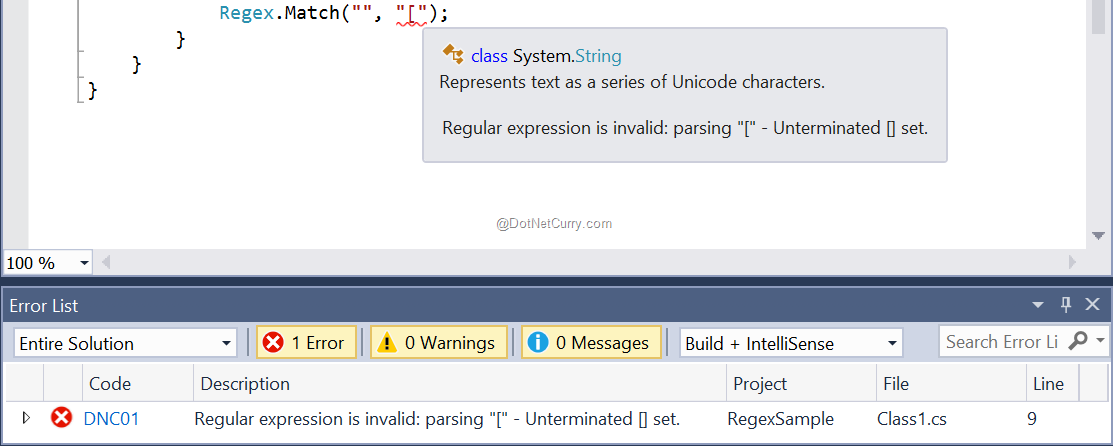Visual Studio Regular Expression

Mac safe for work. The backslash () in a regular expression indicates one of the following:

Developer community 2. Search Search Microsoft.com. But if there was any reason that I was going to learn to use them, it would be when doing searches in Visual Studio. For one thing, regular expressions are easy to invoke when doing a search: When you press CtrlF to get the Find dialog box, all you have to do is click the asterisk (.) to the left of the of scope dropdown list to start using regular expressions in your search. This extension provides tools for Visual Studio 2017 and 2019 that help you to create regular expressions. Regex Editor allows you to create and to test various aspects of the regular expressions Quick Ref Pane allows you to keep information on various elements of. The characters included in the Character or sequence column are special regular expression language elements. To match them in a regular expression, they must be escaped or included in a positive character group. For example, the regular expression $d+ or $d+ matches '$1200'. A: Matches a bell (alarm) character, u0007.
Regular Expressions Visual Studio Code
The character that follows it is a special character, as shown in the table in the following section. Free flash for mac. For example,
bis an anchor that indicates that a regular expression match should begin on a word boundary,trepresents a tab, andx020represents a space.A character that otherwise would be interpreted as an unescaped language construct should be interpreted literally. For example, a brace (
{) begins the definition of a quantifier, but a backslash followed by a brace ({) indicates that the regular expression engine should match the brace. Similarly, a single backslash marks the beginning of an escaped language construct, but two backslashes () indicate that the regular expression engine should match the backslash.


Note
Character escapes are recognized in regular expression patterns but not in replacement patterns.
Visual Studio Expression Builder
Character Escapes in .NET
The following table lists the character escapes supported by regular expressions in .NET. Camera dvr software for mac.
| Character or sequence | Description |
|---|---|
| All characters except for the following: . $ ^ { [ ( | ) * + ? | Characters other than those listed in the Character or sequence column have no special meaning in regular expressions; they match themselves. The characters included in the Character or sequence column are special regular expression language elements. To match them in a regular expression, they must be escaped or included in a positive character group. For example, the regular expression $d+ or [$]d+ matches '$1200'. |
a | Matches a bell (alarm) character, u0007. |
b | In a [character_group] character class, matches a backspace, u0008. (See Character Classes.) Outside a character class, b is an anchor that matches a word boundary. (See Anchors.) |
t | Matches a tab, u0009. |
r | Matches a carriage return, u000D. Note that r is not equivalent to the newline character, n. |
v | Matches a vertical tab, u000B. |
f | Matches a form feed, u000C. |
n | Matches a new line, u000A. |
e | Matches an escape, u001B. |
| Matches an ASCII character, where nnn consists of two or three digits that represent the octal character code. For example, 040 represents a space character. This construct is interpreted as a backreference if it has only one digit (for example, 2) or if it corresponds to the number of a capturing group. (See Backreference Constructs.) |
xnn | Matches an ASCII character, where nn is a two-digit hexadecimal character code. |
cX | Matches an ASCII control character, where X is the letter of the control character. For example, cC is CTRL-C. |
unnnn | Matches a UTF-16 code unit whose value is nnnn hexadecimal. Note: The Perl 5 character escape that is used to specify Unicode is not supported by .NET. The Perl 5 character escape has the form x{####…}, where ####… is a series of hexadecimal digits. Instead, use unnnn. |
| When followed by a character that is not recognized as an escaped character, matches that character. For example, * matches an asterisk (*) and is the same as x2A. |
An Example
The following example illustrates the use of character escapes in a regular expression. It parses a string that contains the names of the world's largest cities and their populations in 2009. Each city name is separated from its population by a tab (t) or a vertical bar (| or u007c). Individual cities and their populations are separated from each other by a carriage return and line feed.

The regular expression G(.+)[tu007c](.+)r?n is interpreted as shown in the following table.
| Pattern | Description |
|---|---|
G | Begin the match where the last match ended. |
(.+) | Match any character one or more times. This is the first capturing group. |
[tu007c] | Match a tab (t) or a vertical bar (|). |
(.+) | Match any character one or more times. This is the second capturing group. |
r?n | Match zero or one occurrence of a carriage return followed by a new line. |
See also
